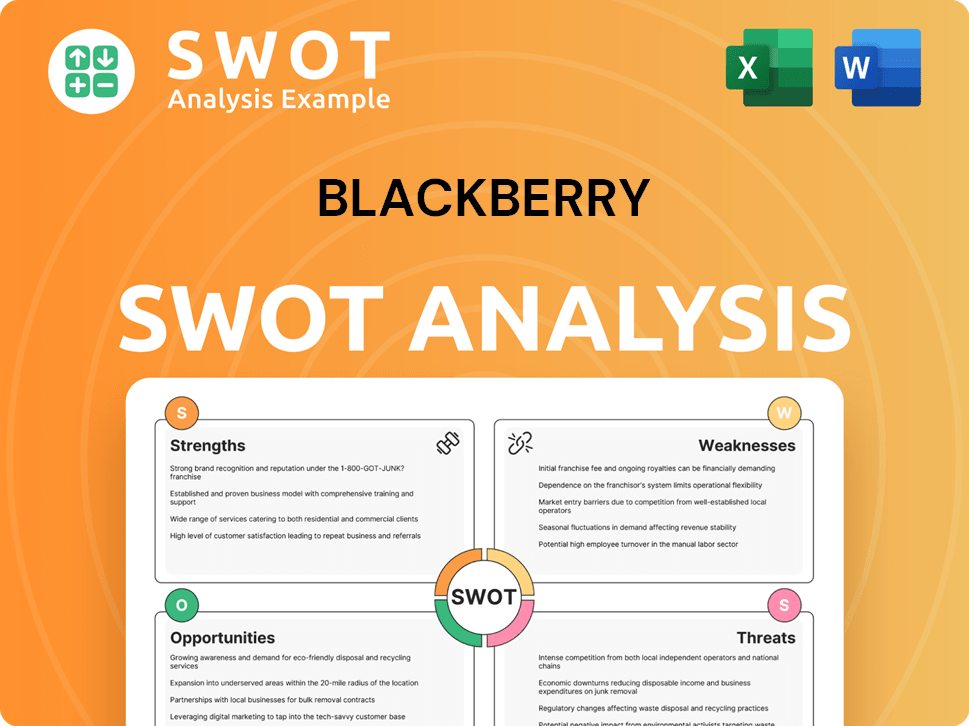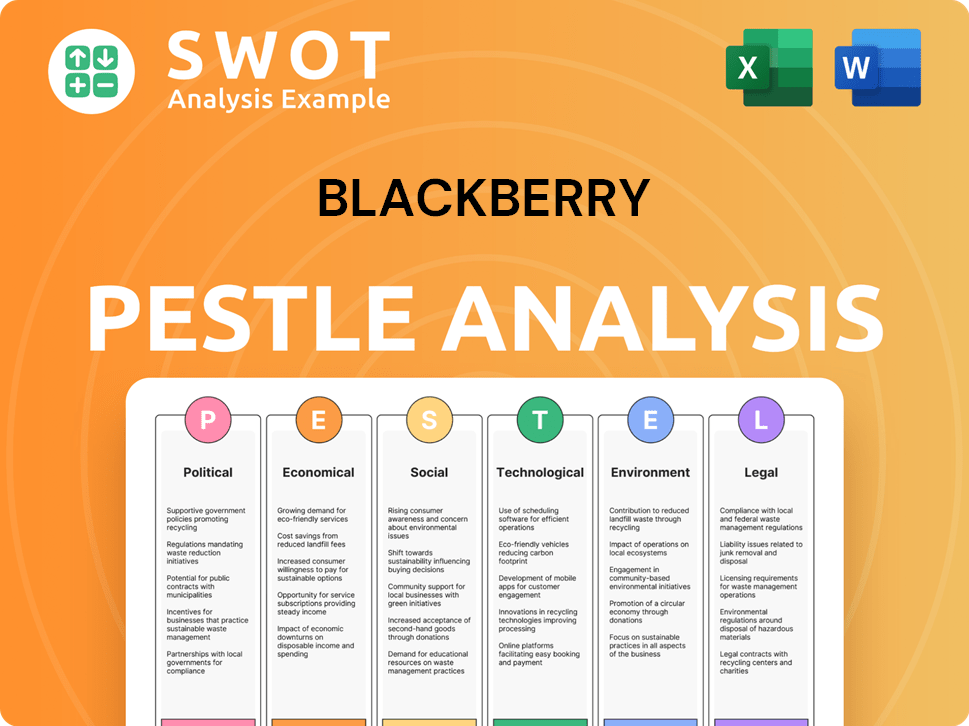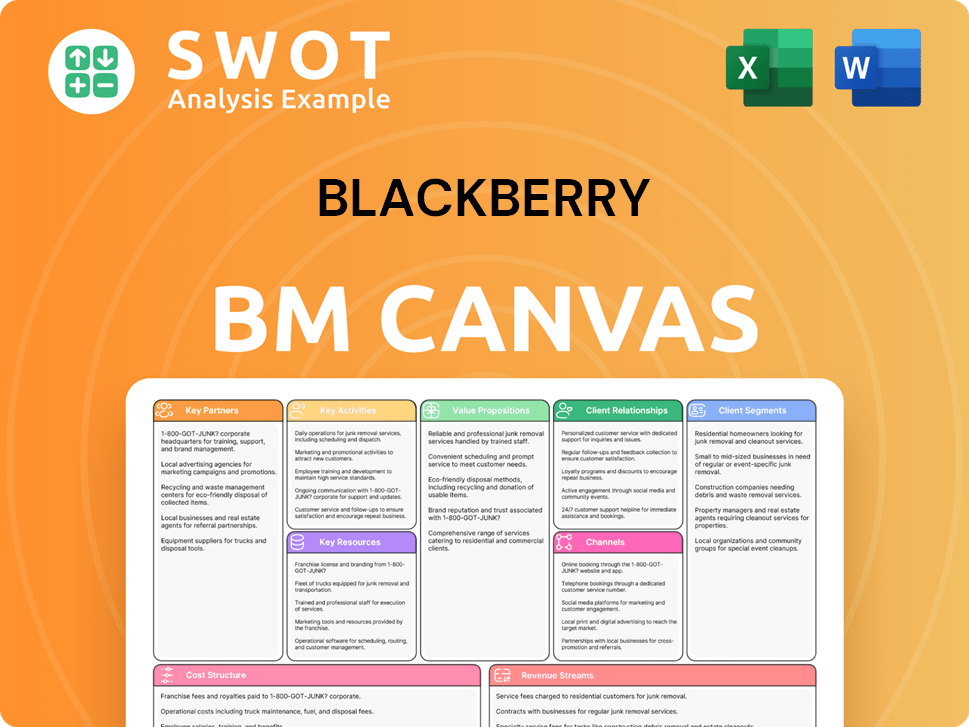BlackBerry Bundle
Can BlackBerry Thrive in Today's Cutthroat Tech Arena?
From dominating the mobile phone market to reinventing itself, BlackBerry's journey is a masterclass in strategic adaptation. But how does this once-iconic brand stack up against its rivals in the complex world of cybersecurity and IoT? This analysis unveils the BlackBerry SWOT Analysis, providing a deep dive into its competitive position.

Understanding the BlackBerry competitive landscape is crucial for evaluating its future. This exploration will identify BlackBerry competitors and provide a thorough BlackBerry market analysis, examining its strategic shifts and the BlackBerry challenges it faces. We'll dissect how BlackBerry's strategy is evolving within the dynamic BlackBerry industry to assess its potential for sustained success and its ability to compete with its main rivals in the current market.
Where Does BlackBerry’ Stand in the Current Market?
BlackBerry Limited has carved out a specific niche in the enterprise software and cybersecurity sectors. Its main focus areas include the automotive and government industries. The company's shift away from consumer hardware has allowed it to concentrate on its strengths in secure, embedded software. This strategic pivot has reshaped the Growth Strategy of BlackBerry.
BlackBerry's competitive landscape is defined by its specialized offerings. The company's products are tailored for high-security and mission-critical applications. Key products include BlackBerry Cylance for endpoint security, BlackBerry UEM for unified endpoint management, BlackBerry AtHoc for critical event management, and BlackBerry QNX for embedded systems. These solutions cater to large enterprises, government agencies, and automotive original equipment manufacturers (OEMs).
BlackBerry's market position is underpinned by its strong presence in the automotive sector, particularly through its QNX operating system. QNX is embedded in over 235 million vehicles globally, making it a key component for ADAS, digital cockpits, and other automotive software. This widespread adoption highlights its leadership in the automotive embedded software market. Furthermore, BlackBerry's heritage in high-security solutions gives it a strong position in government and regulated industries.
BlackBerry's core operations revolve around enterprise software and services, with a strong emphasis on cybersecurity and embedded systems. The company provides solutions for endpoint security, unified endpoint management, critical event management, and automotive embedded systems. Its focus is on secure, reliable, and high-performance software tailored for specific industry needs.
The value proposition of BlackBerry lies in its ability to provide secure, reliable, and specialized software solutions. It offers advanced security features, robust endpoint management, and critical event management capabilities. The company's QNX operating system provides a critical foundation for automotive applications, ensuring safety and performance. This is a key element of the BlackBerry competitive landscape.
BlackBerry's market focus is primarily on large enterprises, government agencies, and automotive OEMs. Its strategy is to offer specialized software solutions that meet the stringent security and performance requirements of these sectors. This targeted approach allows BlackBerry to maintain a competitive edge in specific market segments.
BlackBerry reported total revenue of $177 million for the fourth quarter of fiscal year 2024. The IoT segment contributed $66 million, and the Cybersecurity segment contributed $92 million. These figures indicate a stable revenue base within the enterprise software and cybersecurity markets. The company's financial performance reflects its strategic shift and focused market approach.
BlackBerry's competitive advantages include its strong position in the automotive sector through QNX, its expertise in cybersecurity, and its focus on secure, embedded software solutions. These strengths enable it to compete effectively in the enterprise software and cybersecurity markets.
- Dominant position in the automotive embedded software market.
- Strong reputation for security and reliability.
- Focus on high-security and mission-critical applications.
- Strategic shift to enterprise software and services.
BlackBerry SWOT Analysis
- Complete SWOT Breakdown
- Fully Customizable
- Editable in Excel & Word
- Professional Formatting
- Investor-Ready Format

Who Are the Main Competitors Challenging BlackBerry?
The Target Market of BlackBerry faces a dynamic and competitive landscape across its core business areas. The company competes in cybersecurity, IoT (particularly automotive), and critical event management, each with its own set of rivals. Understanding the competitive dynamics is crucial for assessing BlackBerry's market position and future prospects. Analyzing the competitive landscape helps in evaluating BlackBerry's strengths, weaknesses, and strategic options.
BlackBerry's ability to navigate this competitive environment will significantly influence its financial performance and market share. The company must continually adapt its strategies to counter the challenges posed by its rivals and capitalize on emerging opportunities. The competitive analysis provides insights into the key players, their strategies, and the overall market trends that shape BlackBerry's business.
BlackBerry's competitive landscape is complex, with different rivals in each segment. The company's success depends on its ability to differentiate its offerings and effectively compete against both established and emerging players. The competitive analysis helps in understanding the challenges and opportunities that BlackBerry faces in the market.
In cybersecurity, BlackBerry faces competition from major players like CrowdStrike, Palo Alto Networks, and Fortinet. These companies offer comprehensive security platforms that compete with BlackBerry Cylance's offerings. Furthermore, Microsoft and Google, with their extensive enterprise security solutions, are significant competitors.
In the IoT sector, specifically automotive embedded software, BlackBerry QNX competes with in-house solutions from automotive OEMs. Wind River (VxWorks RTOS) and various Linux distributions also pose competition. The influence of tech giants like Google (Android Automotive) and Apple (CarPlay) further shapes the competitive landscape.
BlackBerry UEM competes with VMware (Workspace ONE), Microsoft (Intune), IBM, and Ivanti in the UEM and EMM market. These competitors often offer broader IT management suites, challenging BlackBerry to differentiate through its security-first approach.
In the critical event management (CEM) space, BlackBerry AtHoc competes with Everbridge. Everbridge provides similar mass notification and incident management platforms. Strategic alliances and mergers, such as Broadcom's acquisition of VMware, also impact the competitive dynamics.
Emerging players in specialized cybersecurity niches or open-source automotive software could disrupt the traditional competitive landscape. The competitive landscape is constantly evolving, requiring BlackBerry to adapt to new challenges and opportunities.
A competitive analysis of BlackBerry's position requires considering its strengths and weaknesses against its rivals. Understanding the market share, product offerings, and strategic initiatives of competitors is essential for effective market analysis. BlackBerry's strategies must address the competitive pressures in each of its key business segments.
The competitive landscape for BlackBerry in 2024 is shaped by the ongoing trends in cybersecurity, IoT, and enterprise software. The company faces established players and emerging disruptors, requiring it to maintain a strong focus on innovation and strategic partnerships. The market is dynamic, with mergers, acquisitions, and new product launches continuously altering the competitive balance.
- Cybersecurity: CrowdStrike, Palo Alto Networks, and Fortinet continue to be major competitors, offering comprehensive security platforms.
- IoT (Automotive): Competition comes from in-house OEM solutions, Wind River, and Linux distributions.
- UEM/EMM: VMware, Microsoft, IBM, and Ivanti are key competitors in the enterprise mobility market.
- CEM: Everbridge is a significant competitor in critical event management.
- Market Dynamics: Strategic alliances and mergers, such as Broadcom's acquisition of VMware, influence the competitive landscape.
BlackBerry PESTLE Analysis
- Covers All 6 PESTLE Categories
- No Research Needed – Save Hours of Work
- Built by Experts, Trusted by Consultants
- Instant Download, Ready to Use
- 100% Editable, Fully Customizable

What Gives BlackBerry a Competitive Edge Over Its Rivals?
The BlackBerry competitive landscape has evolved significantly, transitioning from a dominant player in the smartphone market to a software and services provider focused on cybersecurity and embedded systems. The company's strategic pivot has allowed it to leverage its core strengths in security and reliability, particularly in sectors like automotive and government. This shift reflects a broader BlackBerry strategy to capitalize on its existing technological expertise and brand reputation in a changing BlackBerry industry.
BlackBerry's market analysis reveals a focus on high-growth areas where its unique capabilities offer a competitive edge. The company faces various BlackBerry challenges, including intense competition and the need to adapt to rapid technological advancements. However, its strategic positioning and proprietary technologies provide a foundation for sustained success, as demonstrated by its performance in the automotive sector and its continued focus on cybersecurity solutions.
BlackBerry's current competitive advantages stem from its legacy in secure communication and its strategic focus on high-security environments. The company's proprietary QNX operating system is a key differentiator, particularly in the automotive industry, where it is embedded in over 235 million vehicles. This, combined with a strong brand reputation and a portfolio of intellectual property, allows BlackBerry to maintain a competitive edge in its target markets.
QNX is a real-time operating system (RTOS) known for its reliability and security, making it ideal for embedded systems. It is a foundational technology in the automotive industry, powering critical vehicle functions. The extensive adoption of QNX, embedded in over 235 million vehicles, creates a significant barrier to entry for competitors.
BlackBerry's cybersecurity solutions leverage AI and ML for predictive threat prevention. This proactive approach differentiates it from traditional signature-based antivirus solutions. The company's focus on regulated industries and governments allows it to build deep relationships and tailor solutions to specific, high-value customer needs.
BlackBerry's strong brand equity, particularly its historical association with secure communication, continues to resonate with enterprise and government clients. This heritage supports its current focus on cybersecurity and embedded systems. The company's reputation for security provides a competitive advantage in a market where trust is paramount.
BlackBerry holds a substantial portfolio of intellectual property, including numerous patents in areas like cybersecurity, mobile communications, and embedded systems. This provides a defensive moat and a basis for innovation. The company's IP portfolio supports its ability to compete in the rapidly evolving technology landscape.
BlackBerry's core strengths lie in its proprietary QNX operating system, its strong brand equity, and its focus on cybersecurity. These advantages are critical in the company's strategic positioning. The company's focus on regulated industries and governments allows it to build deep relationships and tailor solutions to specific needs.
- QNX in Automotive: Dominant position in the automotive industry with QNX embedded in over 235 million vehicles.
- Cybersecurity Focus: Leveraging AI and ML for predictive threat prevention in a rapidly evolving cybersecurity landscape.
- Strong Brand: Historical association with secure communication, resonating with enterprise and government clients.
- IP Portfolio: Substantial intellectual property in cybersecurity, mobile communications, and embedded systems.
For a deeper dive into BlackBerry's business model and revenue streams, consider reading this article: Revenue Streams & Business Model of BlackBerry.
BlackBerry Business Model Canvas
- Complete 9-Block Business Model Canvas
- Effortlessly Communicate Your Business Strategy
- Investor-Ready BMC Format
- 100% Editable and Customizable
- Clear and Structured Layout

What Industry Trends Are Reshaping BlackBerry’s Competitive Landscape?
The BlackBerry competitive landscape is significantly influenced by industry dynamics, including the growth of the Internet of Things (IoT), the increasing sophistication of cyberattacks, and the demand for secure digital infrastructure. These trends present both opportunities and challenges for the company. Understanding these factors is key to assessing BlackBerry's market analysis and future prospects.
The company faces the ongoing need to innovate in cybersecurity to stay ahead of evolving threats, while also navigating regulatory changes and the competitive landscape. Let's examine the key trends, challenges, and opportunities shaping BlackBerry's industry position.
The IoT sector's expansion, particularly in the automotive industry, offers a substantial opportunity for BlackBerry QNX, which is critical in next-generation vehicles. Cybersecurity threats are becoming more complex, boosting demand for BlackBerry's cybersecurity solutions, such as Cylance and UEM. Regulatory changes, including new data privacy laws, are also creating opportunities for BlackBerry.
The rise of open-source alternatives in embedded systems could pressure QNX's market share. Competition from larger tech companies in cybersecurity and IoT poses a threat. Effectively integrating diverse product lines to offer a unified value proposition remains a challenge. The company needs to stay ahead of evolving cyber threats, which require continuous investment in R&D.
Expanding into emerging IoT verticals beyond automotive, such as industrial IoT and smart medical devices, presents significant growth potential. Innovations in AI-driven cybersecurity, particularly in threat prediction and response, could strengthen its competitive advantage. Strategic partnerships with cloud providers and other technology companies could broaden its reach and enhance its solution offerings.
BlackBerry is likely to evolve into a more integrated security platform provider, leveraging its strengths in endpoint security and embedded systems. The company's strategy will likely focus on continued innovation in AI and machine learning for cybersecurity, expanding its QNX presence in new automotive applications, and exploring strategic acquisitions to bolster its portfolio.
BlackBerry's strategy involves a focus on AI-driven cybersecurity and expansion within the automotive sector. Key competitive advantages include its expertise in endpoint security, unified endpoint management, and embedded systems. The company is aiming to address the holistic security needs of enterprises and governments. For a deeper dive into how the company has positioned itself, consider reading about the Marketing Strategy of BlackBerry.
- Focus on AI and Machine Learning: Enhancing cybersecurity solutions through advanced technologies.
- QNX Expansion: Increasing presence in automotive applications and other embedded systems.
- Strategic Partnerships: Collaborating with cloud providers and other tech companies to broaden reach.
- Product Integration: Unifying diverse product lines to offer a more cohesive value proposition.
BlackBerry Porter's Five Forces Analysis
- Covers All 5 Competitive Forces in Detail
- Structured for Consultants, Students, and Founders
- 100% Editable in Microsoft Word & Excel
- Instant Digital Download – Use Immediately
- Compatible with Mac & PC – Fully Unlocked

Related Blogs
- What are Mission Vision & Core Values of BlackBerry Company?
- What is Growth Strategy and Future Prospects of BlackBerry Company?
- How Does BlackBerry Company Work?
- What is Sales and Marketing Strategy of BlackBerry Company?
- What is Brief History of BlackBerry Company?
- Who Owns BlackBerry Company?
- What is Customer Demographics and Target Market of BlackBerry Company?
Disclaimer
All information, articles, and product details provided on this website are for general informational and educational purposes only. We do not claim any ownership over, nor do we intend to infringe upon, any trademarks, copyrights, logos, brand names, or other intellectual property mentioned or depicted on this site. Such intellectual property remains the property of its respective owners, and any references here are made solely for identification or informational purposes, without implying any affiliation, endorsement, or partnership.
We make no representations or warranties, express or implied, regarding the accuracy, completeness, or suitability of any content or products presented. Nothing on this website should be construed as legal, tax, investment, financial, medical, or other professional advice. In addition, no part of this site—including articles or product references—constitutes a solicitation, recommendation, endorsement, advertisement, or offer to buy or sell any securities, franchises, or other financial instruments, particularly in jurisdictions where such activity would be unlawful.
All content is of a general nature and may not address the specific circumstances of any individual or entity. It is not a substitute for professional advice or services. Any actions you take based on the information provided here are strictly at your own risk. You accept full responsibility for any decisions or outcomes arising from your use of this website and agree to release us from any liability in connection with your use of, or reliance upon, the content or products found herein.